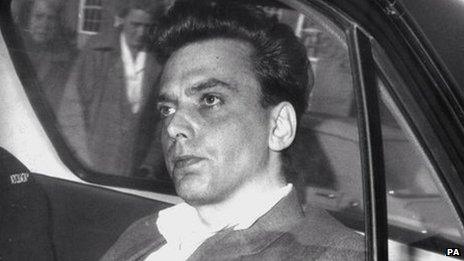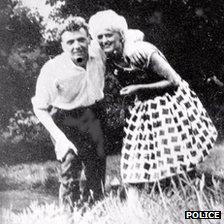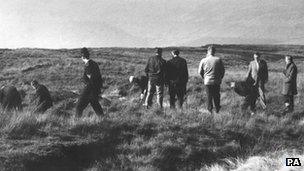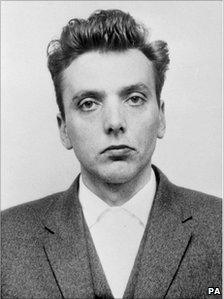Profile: Moors Murderer Ian Brady
- Published

Moors Murderer Ian Brady was jailed in 1966 and moved to a high security psychiatric hospital after he was diagnosed as a psychopath 19 years later
Moors Murderer Ian Brady wants to be allowed to die.
The 75-year-old has been on hunger strike in recent years at Ashworth psychiatric hospital in Maghull, being force-fed daily to keep him alive.
He has requested a transfer to a Scottish prison, where there is no precedent for force-feeding prisoners on hunger strike.
Brady's fate will be determined by a mental health tribunal. A previous tribunal hearing in July 2012 was postponed after Brady fell ill days beforehand.
Few killers achieved the notoriety, or attracted as much public loathing, as the so-called "Moors Murderer".
He was jailed in 1966 for three counts of murder, and has been detained at the top-security psychiatric hospital since 1985.
But the real number of victims was higher: over a period of 18 months, Brady and his accomplice, Myra Hindley, kidnapped and murdered five children and teenagers in north-west England.
They buried at least three of their victims on Saddleworth Moor, near the Lancashire town of Oldham.

Murders committed by Ian Brady and Myra Hindley shocked Britain
Details of the crimes shocked Britain, not least because Brady's accomplice was a woman but also because of the complete lack of remorse either showed during the subsequent trial.
Nazi books
Brady was born Ian Stewart on 2 January 1938, the illegitimate son of a Scottish waitress.
His violent personality was shaped by an unstable background. His mother neglected him and he was raised by foster parents in the Gorbals, Glasgow's toughest slum.
After a spree of petty crime as a teenager the courts sent him to Manchester to live with his mother and her new husband, Patrick Brady.
Ian assumed his stepfather's name, continued his criminal activities and developed into a fully-fledged teenage alcoholic.
By now he had acquired new interests, building up a library of books on Nazi Germany, sadism and sexual perversion.
He first met Myra Hindley when she worked as a secretary at the same company in Manchester in which he was working as a stores clerk.
For Hindley it was love at first sight. Brady impressed her by reading Mein Kampf in the original German.
Baffled authorities
As their relationship developed, they began taking obscene photographs of each other before turning their attention to kidnapping, child molestation and murder.
Between July 1963 and December 1964, 16-year-old Pauline Reade, 12-year-old John Kilbride and Keith Bennett, also 12, were reported missing, all in the Manchester area.
Another victim, 10-year-old Lesley Ann Downey, disappeared on 26 December 1964.
Authorities were baffled by what they referred to as the "unrelated" cases, and were left without a single piece of solid evidence.
In the meantime, Brady and Hindley were intent on a campaign to corrupt Myra's brother-in-law, David Smith, and recruit him into their circle.
A petty criminal with convictions of his own, Smith was amused when the conversation turned to murder and he questioned Brady's ability to follow it through.
On 6 October 1965, Brady offered a practical demonstration with Edward Evans, a homosexual teenager, striking him fourteen times with a hatchet before finishing the job by strangling him.
Horrified, Smith phoned the police next morning, directing them to Brady's address.
Police search
The officers found Brady and Hindley at home. In a room upstairs they discovered Mr Evans' corpse. The bloody murder weapon was also recovered, along with Brady's collection of books on perversion and sadism.
A 12-year-old girl and neighbour recalled several trips she had made with the couple to Saddleworth Moor, and the police launched a search which uncovered the body of Lesley Ann Downey on 16 October.
Four days later, another search of Brady's flat turned up two left luggage tickets for Manchester Central Station, leading police to a pair of suitcases.

Police combed Saddleworth Moor to find the bodies of children killed by Brady and Hindley
Inside the cases, they found nude photographs of Lesley Ann Downey, along with tape recordings of her final tortured moments, pleading for her life as she was brutally abused.
A series of seemingly innocent snapshots depicted portions of Saddleworth Moor, and detectives paid another visit to the desolate region on 21 October, unearthing the body of John Kilbride.
Police announced that they were opening their files on eight missing persons, who had disappeared over the previous four years, but no new charges had been added by the time the couple went to trial.
Jurors were horrified by the Downey tape, and by Brady's bland description of the recording as "unusual".
On 6 May 1966, both defendants were convicted of killing Edward Evans and Lesley Ann Downey. Brady was also convicted of murdering John Kilbride, while Myra Hindley was convicted as an accessory after the fact.
Return to the moors
Brady was sentenced to concurrent life terms on each count, while Hindley received two life terms plus seven years in the Kilbride case.
Nineteen years later, in November 1985, Brady was transferred from prison to a maximum-security hospital after being diagnosed a psychopath.
There, he confessed to the murders of Pauline Reade and Keith Bennett, whose remains had still not been found, in an interview with tabloid reporters.
Searchers returned to the moors a year later, with Myra Hindley joining them for an abortive outing in December 1986 and Brady joining them in 1987.
They uncovered the remains of Pauline Reade on 30 June 1987, nearly a quarter-century after her disappearance.

In later years Hindley claimed Brady had forced her into the murders
It took pathologists a month to decide that the girl had been sexually assaulted, her throat slashed from behind.
The whereabouts of the remains of Keith Bennett are still unknown.
The Director of Public Prosecutions announced in 1988 that, in the public interest, there would be no prosecution of the murders of Pauline Reade and Keith Bennett.
In August 1987, Brady posted a letter to the BBC, containing sketchy information on five "new" murders he said he had committed, but police decided there was insufficient evidence to pursue an official investigation.
Brady had accepted from the start that he would never be released, unlike Myra Hindley who, in trying to secure parole, claimed that Brady had forced her into the murders by abusing and torturing her into submission.
But Brady reacted to her allegation by claiming that "for 20 years I continued to ratify the cover I had given her at the trial whilst, in contrast, she systematically began to fabricate upon it to my detriment".
Myra Hindley died in 2002, still a prisoner.
Brady has said he would rather die quickly than rot slowly in jail.
But his attempts to force the authorities to allow him to starve himself to death have failed. In March 2000 a judge described his hunger strike as part of his "obsessive need to exercise control".
The mental health tribunal's decision on his request to be moved to prison will dictate whether or not Brady can take control of how he dies.
- Published3 July 2012